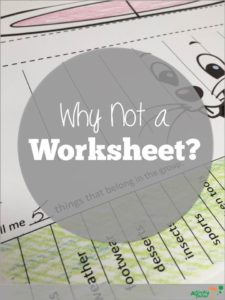You know what (teachers and) SLPs love about worksheets? You print and go. There’s no mess. Plus, you have something to send home to show, 1) yes, we had speech today, 2) yes, we are still working on that goal and 3) please remember to work on this at home too.
You know what kids hate about worksheets? They’re work and they’re boring.
No big news flash here, right?
But there are happy mediums.
I loved Highlights growing up—the hidden pics and all the other puzzles. Well, basically those are worksheets. So the trick, especially at this time of year, is implementing the ease of worksheets, but with the fun of just about anything else.
With my elementary aged speech students, I’m apt to grab dot-to-dot pages or mazes and quickly customize them to be “speech” work. Color Mountain has easy, free ones. I’ll print one that has our target sound, let say the “airplane” one for “air” or “pl” and highlight every few dots. Then I have them count substituting the target word when there’s a highlighted dot. “1, 2, 3, plane, 5, 6, plane.” For mazes, they might need to say the word or make up a sentence every time they hit a dead end, or they may need to say the word 5x when they finish. (In groups, it gives them something to do which they wait their turn.)
Cootie catchers are another fun, child friendly way to work on speech goals. You can write targets/prompts on the flaps or even just numbers that indicate the number of repetitions. Click on the link for folding directions, click here for a list of “good fortunes” you can put inside.
Tic-Tac-Toe, Triangles, Stop-Gate and Sink a Ship are all classic pencil/paper games that take no time to set up and provide lots of fun for students.
I love no mess crafts which are fun to create, look adorable and require minimal effort on my part.
Coloring sheets are another easy option especially when paired with “I spy” type riddles.
Got any quick worksheet/non-worksheet ideas you use? Please list below!






